ALMACO JACK
Scientific Name: Seriola rivoliana
Local Name: Phathar Kokari
There so far have been no records of amberjack in our waters, however we do come across its lesser cousin the Almaco Jack. They feed, both day and night, on other, smaller, fish, such as baitfish and small squid. This species is more widely caught than its larger counterpart the Greater amberjack. Can be effectively caught on deep seamounts with the use of jigs.
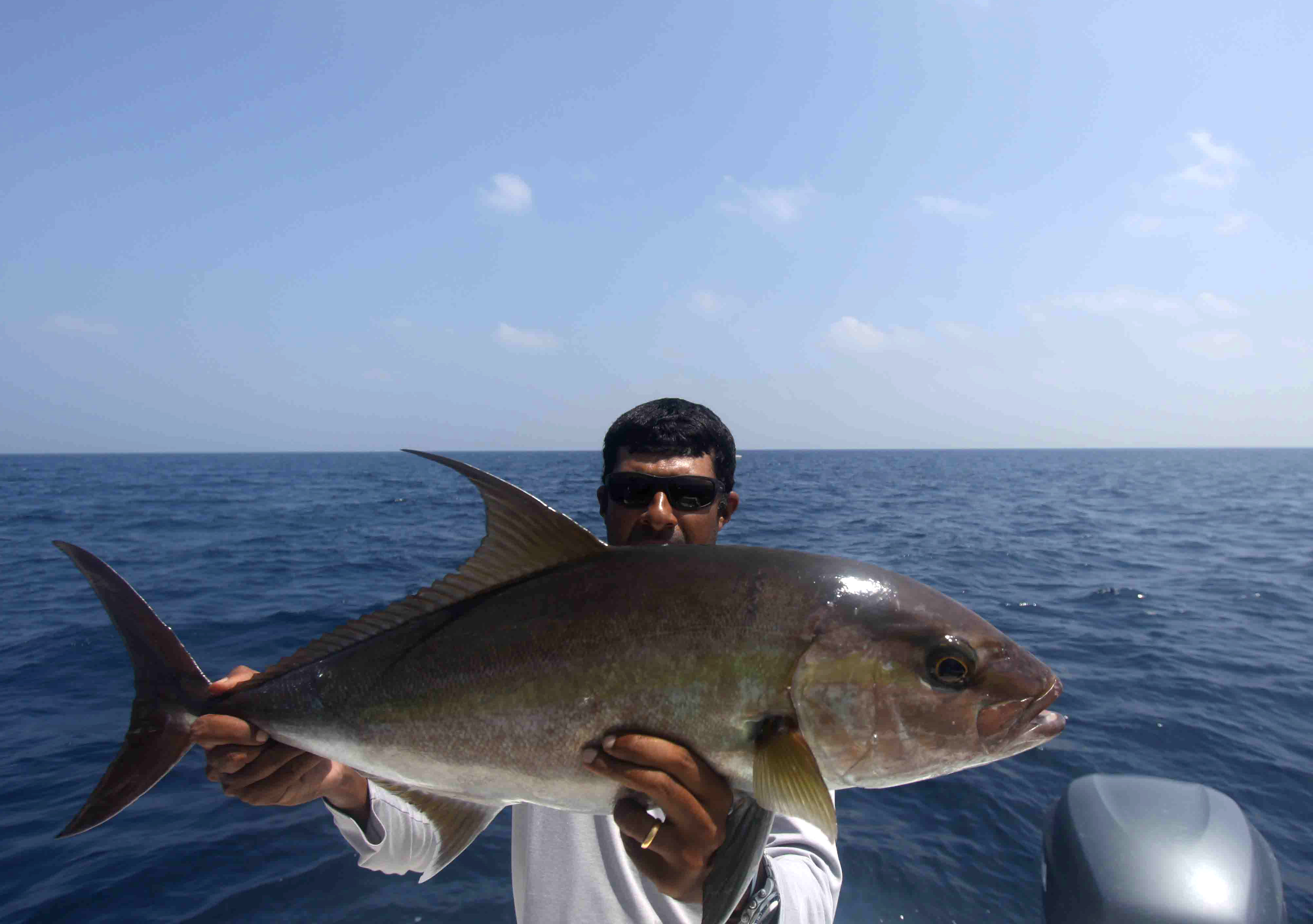

BLUEFIN TREVALLY
Scientific Name: Caranx melampygus
Local Name: Neela Kokari
Known as the bluefin jack, bluefin kingfish, bluefinned crevalle, blue ulua, omilu and spotted trevally, is a species of large, widely distributed marine fish classified in the jack family, Carangidae. The bluefin trevally is distributed throughout the tropical waters of the Indian and Pacific Oceans, ranging from Eastern Africa in the west to Central America in the east, including Japan in the north and Australia in the south. Bluefin trevally are easily recognized by their electric blue fins, tapered snout and numerous blue and black spots on their sides The bluefin trevally is a popular target of recreational fishermen. This species is targeted with the use of artificial surface lures, sinking stickbaits and natural baits.
DOGTOOTH TUNA
Scientific Name: Gymnosarda unicolor
Local Name: Surmai Bangadi
It has the large teeth and straight edged first dorsal fin characteristic of the smaller bonitos (genus Sarda) and although it far exceeds them in size, reaching weights of over 150 kilograms, is considered more closely related to them than to the true tunas. The Andaman Sea teems with dogtooth tuna and they are quite easy to catch. We are lucky enough to also be able to catch them on popper, which is very rare. Dogtooth tuna frequent reef environments, with smaller fish being more commonly found near shallow reef areas and larger ones haunting deep reef drop off areas, seamounts and steep underwater walls. The dogtooth tuna is one of the apex non-pelagic predators in its environment, sharing that position with Giant Trevally, Napoleon Wrasse, and large groupers, as well as reef, bull and tiger sharks.
In the last 10 to 15 years there has been more dedicated effort directed at this species because of its rarity and sporting qualities. Dogtooth tuna are now a highly coveted prize by many European and Asian sports anglers. Large specimens are seldom found where there is significant fishing pressure and can be one of the most difficult gamefish to capture. High speed jigging with a variety of metal lures has increased tremendously in popularity in the last several years as advancements in tackle technology have resulted in lightweight rods and reels that are capable of handling heavy spectra-type braided lines to catch these fish.
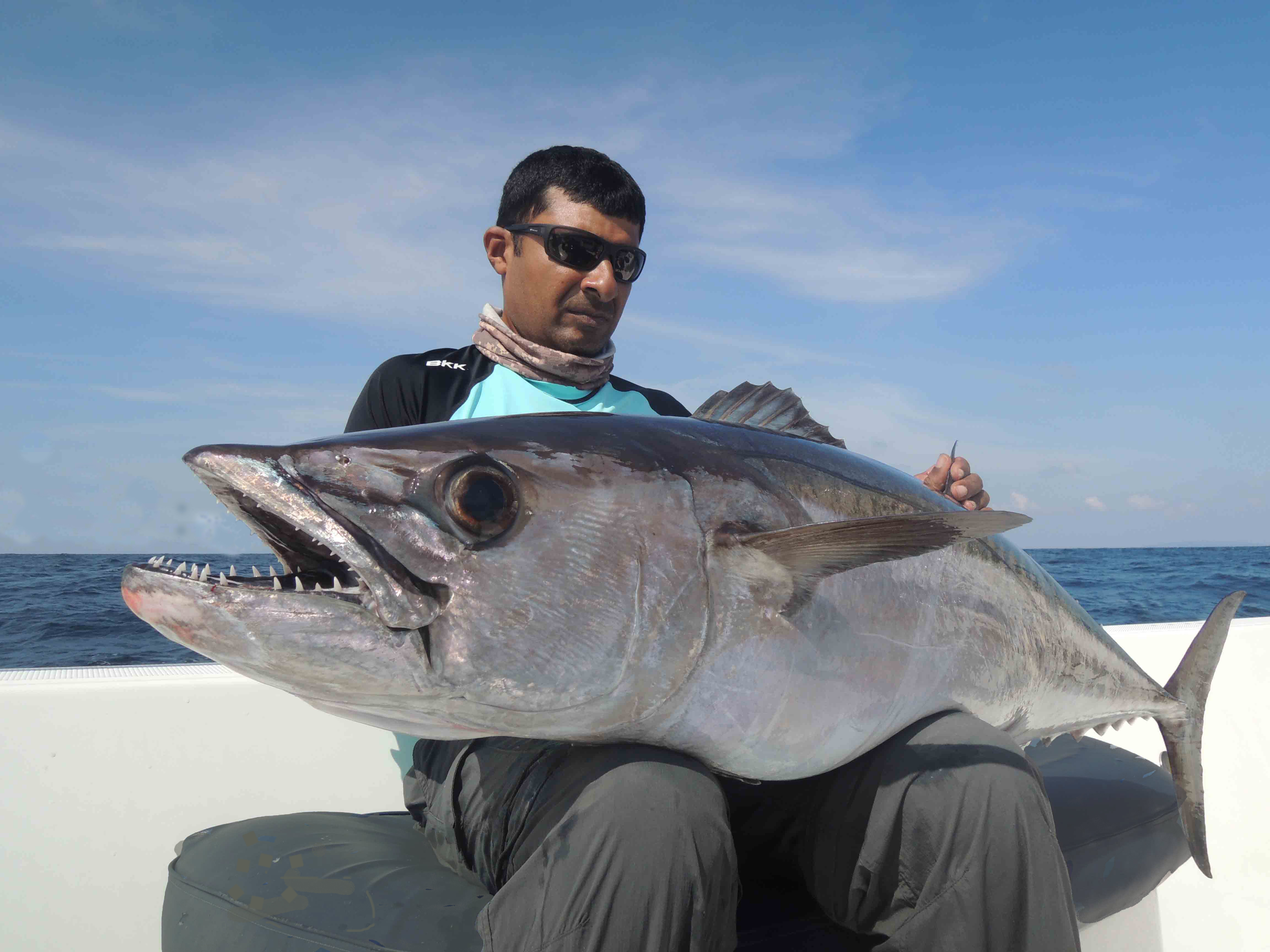
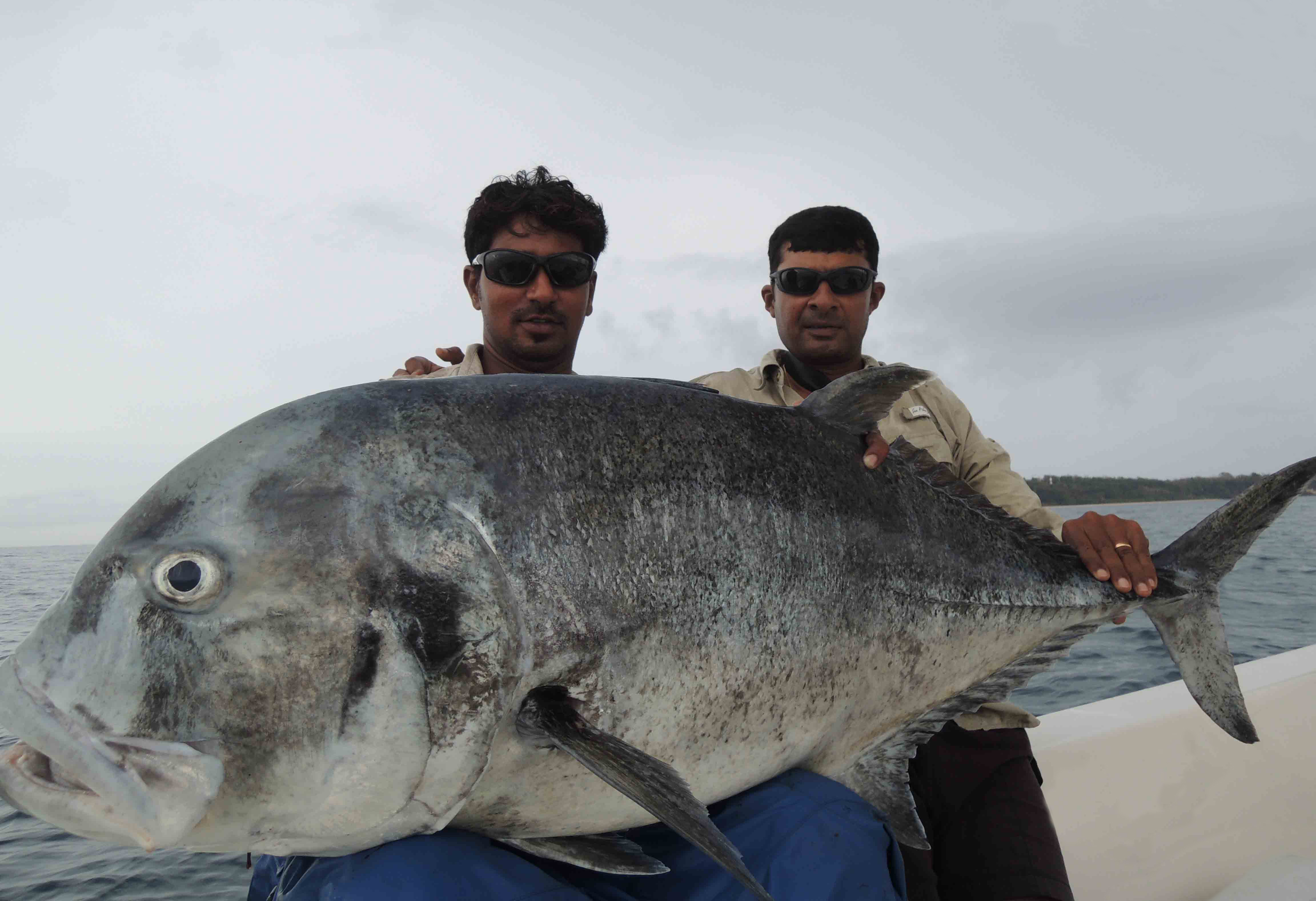
GIANT TREVALLY
Scientific Name: Caranx ignobilis
Local Name: Jaat Kokari
Giant trevally, also known as the giant kingfish, barrier trevally, ulua, or GT, is classified in the jack family, Carangidae. The giant trevally is distributed throughout the tropical waters of the Indo-Pacific region, with a range stretching from South Africa in the west to Hawaii in the east, including Japan in the north and Australia in the south. It is distinguished by its steep head profile, strong tail scutes, and a variety of other more detailed anatomical features. It is the largest fish in the genus Caranx, growing to a maximum known size of 170 cm and a weight of 80 kg. The giant trevally is a powerful apex predator in most of its habitats, and is known to hunt individually and in schools. The fish grows relatively fast, reaching sexual maturity at a length of around 60 cm at three years of age.
This species of fish has a dedicated following of anglers who travel the world in search of pristine areas where these fish can be caught. The preferred method of catching this species is by the use of surface lures, but they can also be caught using a wide array of techniques.
GOLDEN TREVALLY
Scientific Name: Gnathanodon speciosus
Local Name: Peela Par Kokari
Also known as the golden kingfish, banded trevally and king trevally. The golden trevally is widely distributed throughout the tropical and subtropical waters of the Indian and Pacific Oceans, ranging from South Africa in the west to Central America in the east, extending to Japan in the north and Australia in the south. It is known to grow to 120 cm in length and 15 kg in weight. The golden trevally is a popular gamefish, taken by bait, lure and fly. The brilliant colouration of juveniles makes this species popular in marine aquariums.

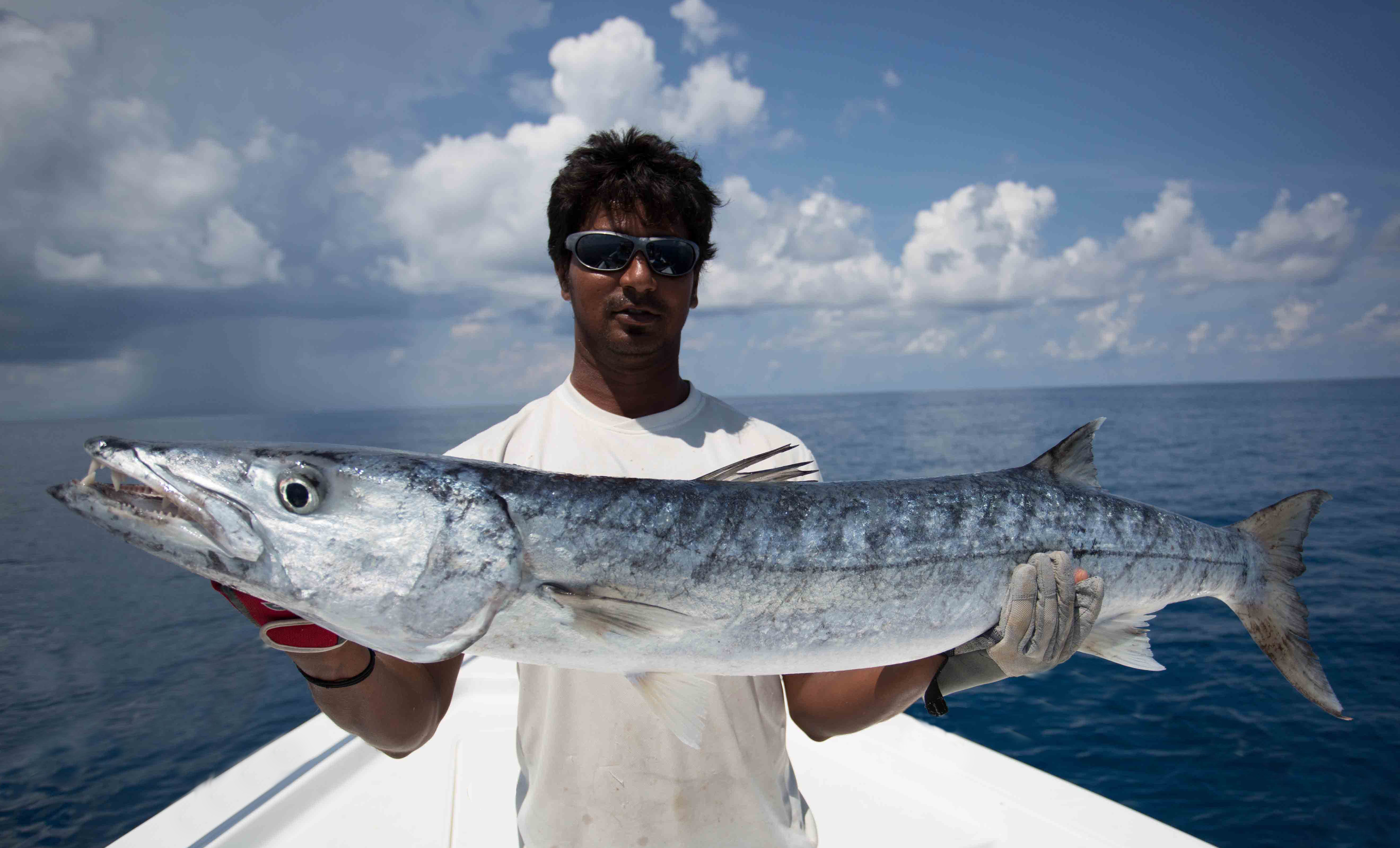
GREAT BARRACUDA
Scientific Name: Sphyraena barracuda
Local Name: Dandus
Great barracudas often grow over 6 feet (1.8 m) long and are a type of ray-finned fish. Great barracudas are large fish. Mature specimens are usually around 60–100 cm record-sized specimen caught on rod-and-reel weighed 46.72 kg (103.0 lb) and measured 1.7 m (5.6 ft), Barracudas possess strong, fang-like teeth that are unequal in size and set in sockets in the jaws and on the roof of the mouth. The head is quite large and is pointed and pike-like. Again they can quite easily be caught trolling or popping. They are relatively hard to catch on jig because of their razor sharp teeth.
GREEN JOBFISH
Scientific Name: Aprion virescens
Local Name: Ruyee
Green jobfish (Aprion virescens), is a fish of the Lutjanidae family, and is the only member of the genus Aprion. This fish is considered one of the ‘brutes’ of the reef often seen snatching lures or bait from other slower fish. They can be effectively caught using surface lures and artificial flies. These fish also can be found on shallow reefs and we wish they got a lot larger.
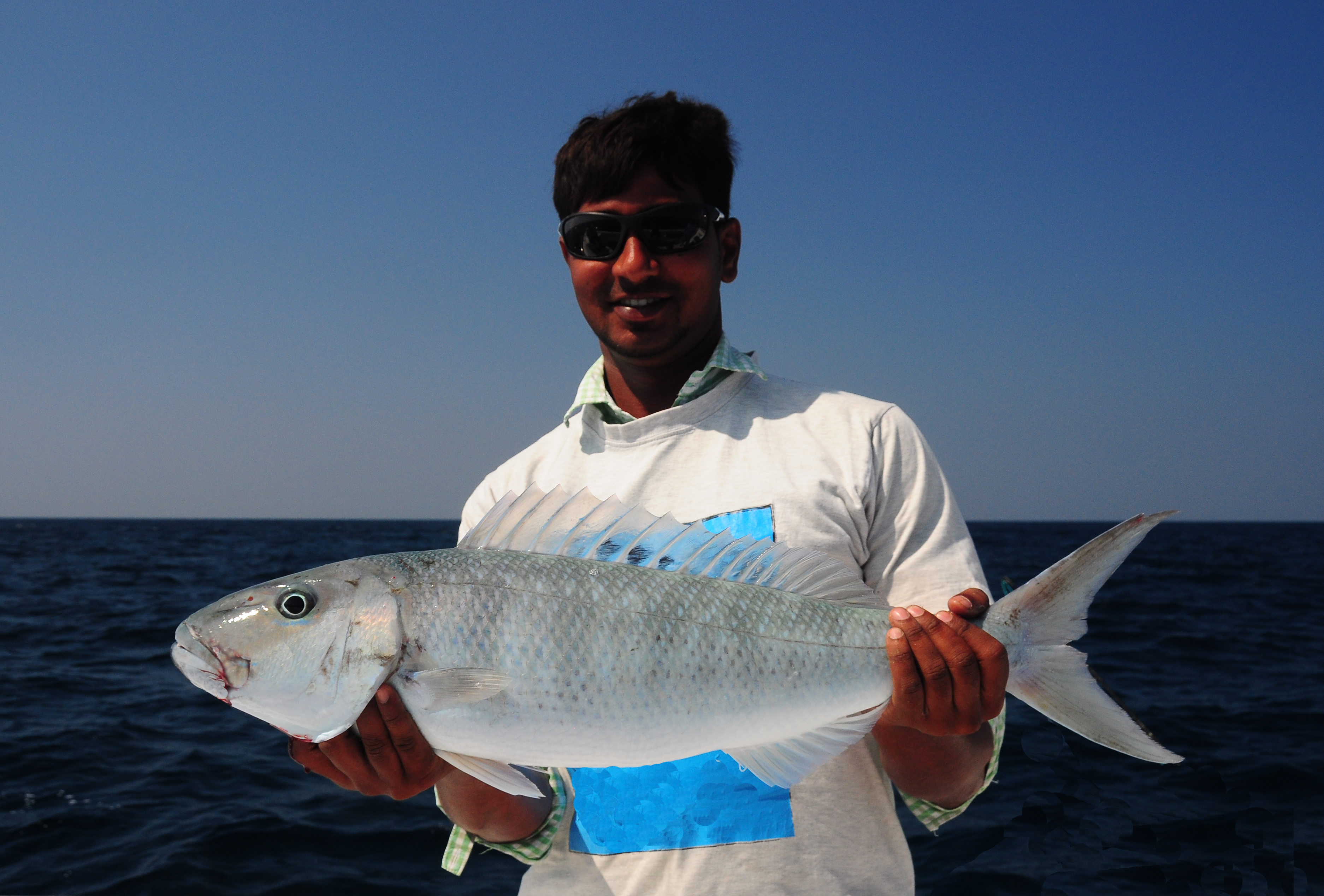
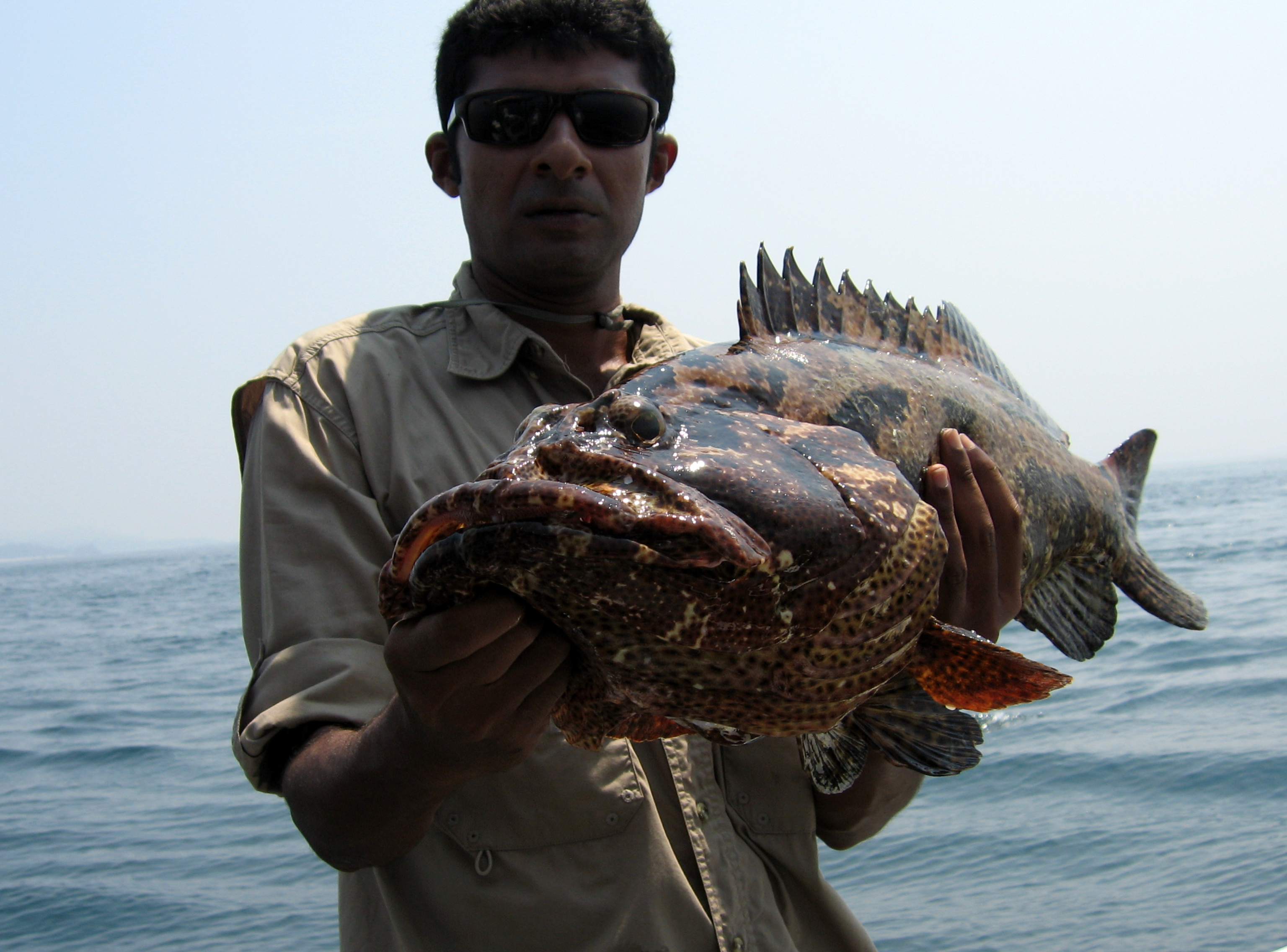
GROUPER
Scientific Name: Epinephelus and Mycteroperca.
Local Name: Gobra
The word “grouper” comes from the word for fish, most widely believed to be from the Portuguese name, garoupa. The grouper is a highly prized sport fishing species and can be a difficult fish to catch based on the fact it dwells close to structure. The best way to catch this species is by jig, but this isn’t the only way, many anglers use rubber shads bounced off the reef and bits of cut bait to entice grouper out of their hiding places in the reef. Care has to be taken while reeling in this species as they are susceptible to barotrauma thus making the task of effectively releasing them a highly specialized one that comes with experience.
INDO PACIFIC SPANISH MACKEREL
Scientific Name: Scomberomorus commerson
Local Name: Jaath Surmai
The Spanish Mackerel is found in a wide ranging area centering in South-east Asia but as far west as the east coast of Africa and from the Middle East and along the northern coastal areas of the Indian Ocean, and as far east as Fiji in the South West Pacific ocean. Trolling which by far is the most effective way to catch this species. They can also be caught on jig. A much sought after fish in the Tourist trade as a food fish.
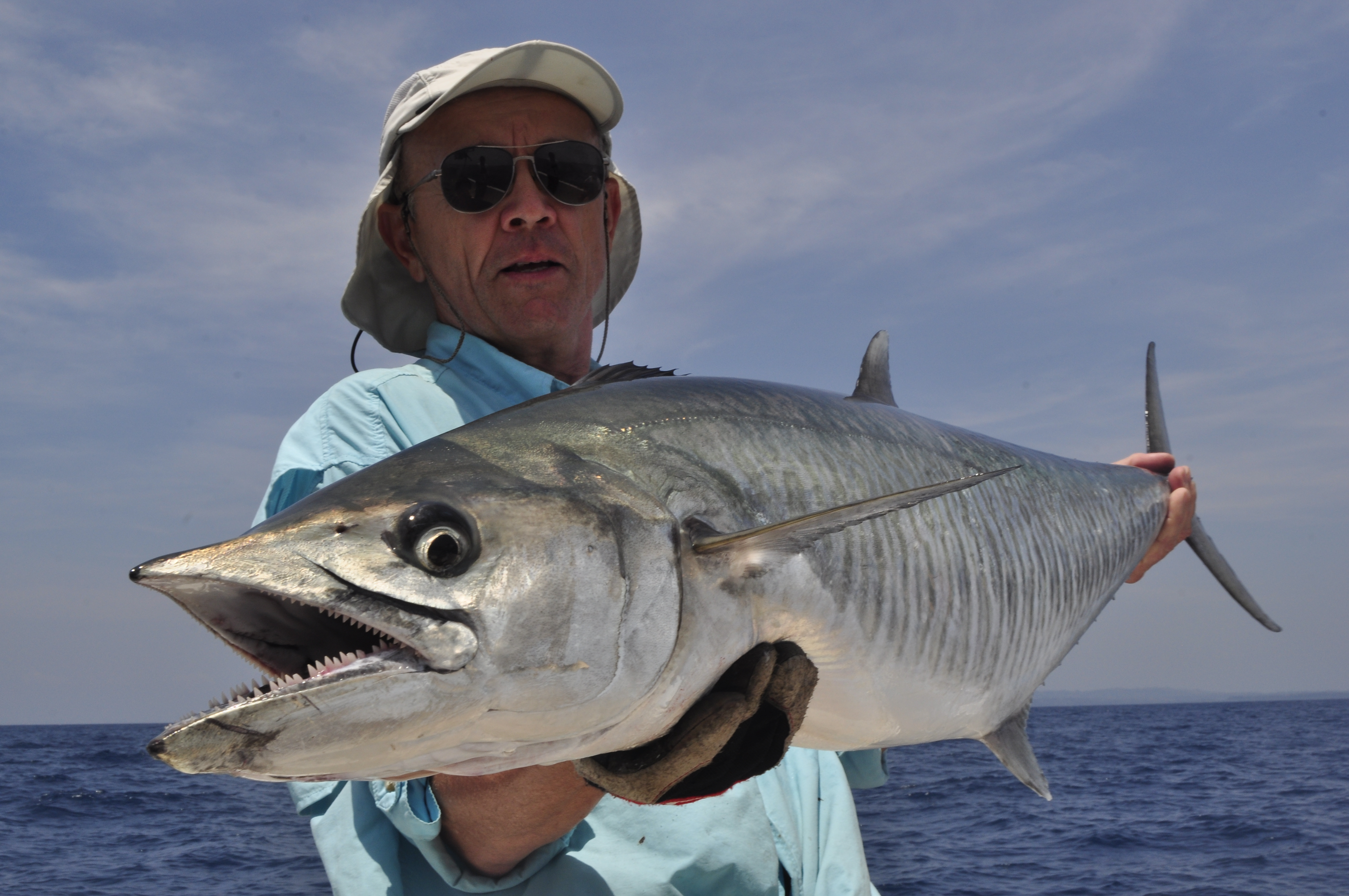

INDO-PACIFIC BLUE MARLIN AND BLACK MARLIN
Scientific Name: Makaira mazara and Makaira indica
Local Name: Hawwa Bill
Marlin inhabit the Andaman Sea. Whilst charter operators or commercial fishermen in the area do not always catch them, they still abound in the area. In fact there is no proper data regarding these fish, or when and where they migrate to. The options are endless for the serious marlin angler as they both can be caught in the same water, which is quite rare. They may be caught trolling skirted resin headed lures or by using live bait.
MAHI MAHI
Scientific Name: Coryphaena hippurus
Local Name: Haathi Kokari
Dorado or Mahi Mahi well offshore around floating debris and are most common in the summer months. Dorado are often found in large schools of similar sized fish. They can easily be targeted with all manner of lures. The most popular way to catch them is on any fast surface-skimming lure that entices them to bite. These fish are also highly prized table fish.

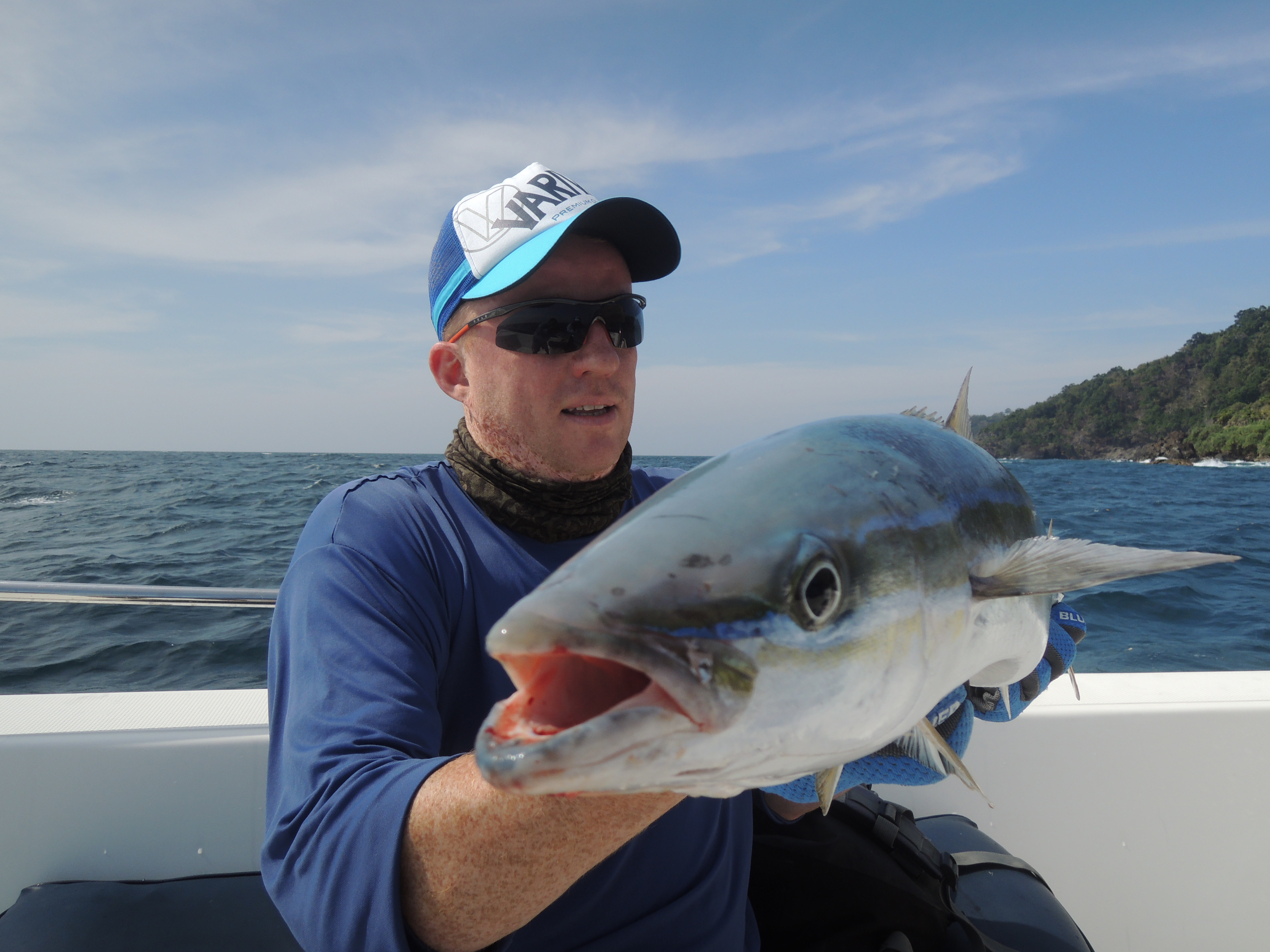
RAINBOW RUNNER
Scientific Name: Elagatis bipinnulata
Local Name: Rainbow Runner
The rainbow runner, also known as the rainbow yellowtail and Spanish jack can be found in huge schools and is a blast to catch on light spinning gear. Rainbow Runners are a common species of pelagic marine fish that make excellent bait. They are much sought after while live bait fishing for Marlin and large Dog Tooth Tuna.
RED BASS OR SNAPPER
Scientific Name: (Lutjanus bohar)
Local Name: Kutha Bhekti
The snapper are mainly a marine species and are a popular sport fish in the tropics. They also are prolific and relatively easy to catch. They are also an ideal fish to catch for novices, as they are hardy and an easy fish to release. They can be caught in a number of ways the most popular being use of small jigs or bait. Larger specimens will also come up off the reef and attack a popper. The most notorious of the lot being the twin spot snapper or the Red Bass.
Sometimes while jigging deep drop-offs we catch the occasional Mangrove Jack which again is a hard fighter.
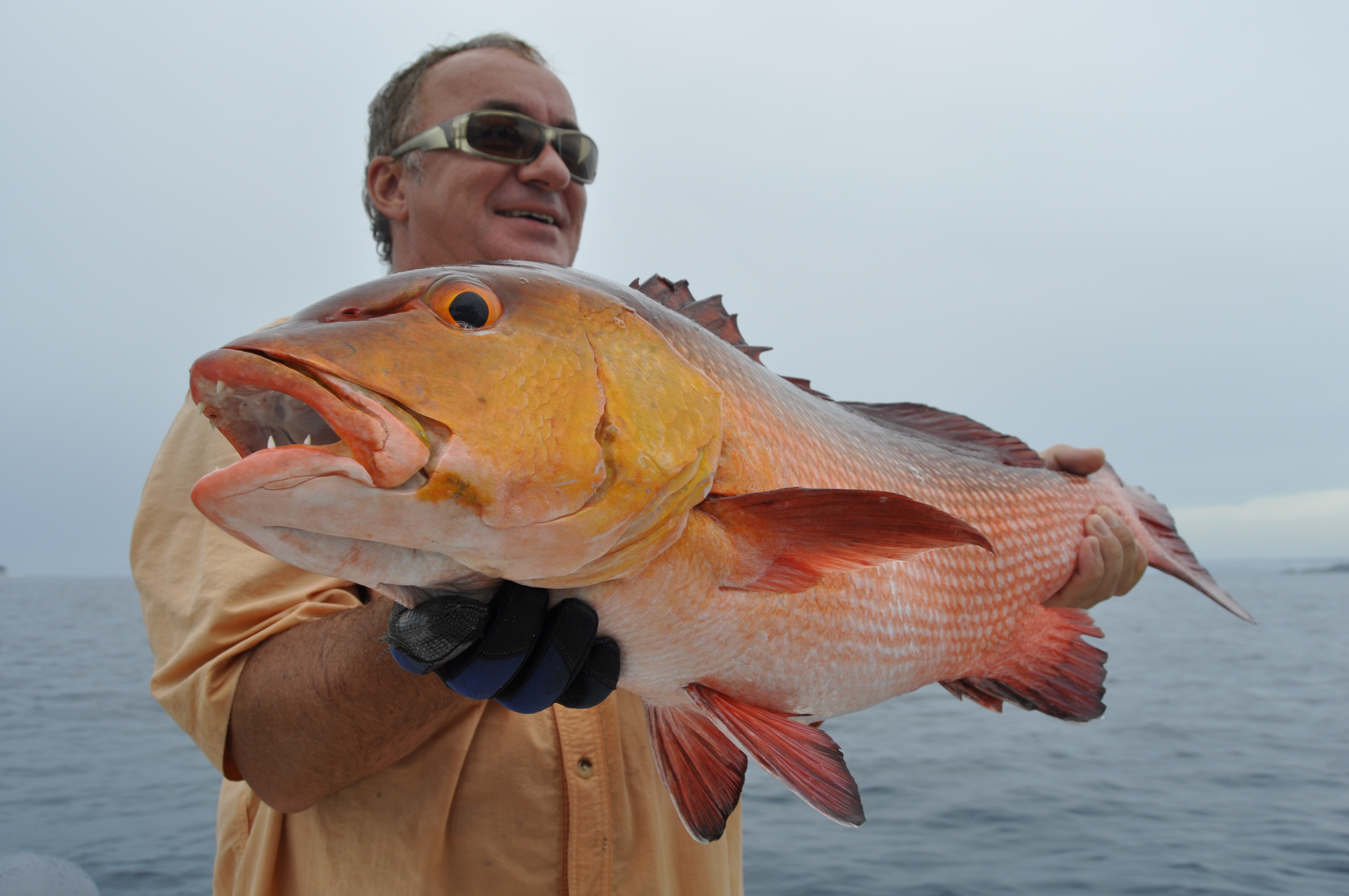

ROSY JOBFISH
Scientific Name: Pristipomoides filamentosus
Local Name: Jaat Mrigal
Often mistaken for the Rusty Jobfish the rosy snapper again is found in the same locations. Not a popular Sport fishing species as they are not caught often. Can be targeted on jig and also bait. These fish are also highly sort after by commercial fishermen who value their light flaky meat.
RUSTY JOBFISH
Scientific Name: Aphareus rutilans
Local Name: Ginny Mrigal
Cuvier, 1830) The Rusty Jobfish is an elongate species with a large lunate tail. It has a large mouth with a protruding lower jaw and minute teeth. Body colour varies from blue-grey to mauve or reddish. These are specialized fish to catch and are out of the realm of the novice angler. Often found in depths ranging from 60 to 120 mtrs they can only be caught on natural baits and speed jigging. They also are found close to drop-offs and they signify the presence of dog tooth tuna in the area. Once we catch a couple of these on jig we know the dog tooth tuna aren’t far behind.


SAILFISH
Scientific Name: Istiophorus platyptreus
Local Name: Chatri Surmai
Sailfish are two species of fish in the genus Istiophorus, living in warmer sections of all the oceans of the world. They are predominately blue to gray in color and have a characteristic erectile dorsal fin known as a sail, which often stretches the entire length of the back. Another notable characteristic is the elongated bill, resembling that of the swordfish and other marlins. They are therefore described as billfish in sport fishing circles. Sailfish are highly prized game fish and are known for their incredible jumps and great speed. They can appear in a startling array of colors, from subdued browns and grays to vibrant purples and even silver.
TUNA
Scientific Name: Thunnus albacares
Local Name: Tuna
The Yellow Fin Tuna (YFT) is a much sought after game fish worldwide. These highly pelagic fish are very rare to catch on popper. They are most often caught trolling or on bait. For a few months annually, large schools of YFT pass through our waters and are within our reach. Fishing for them is quite spectacular.
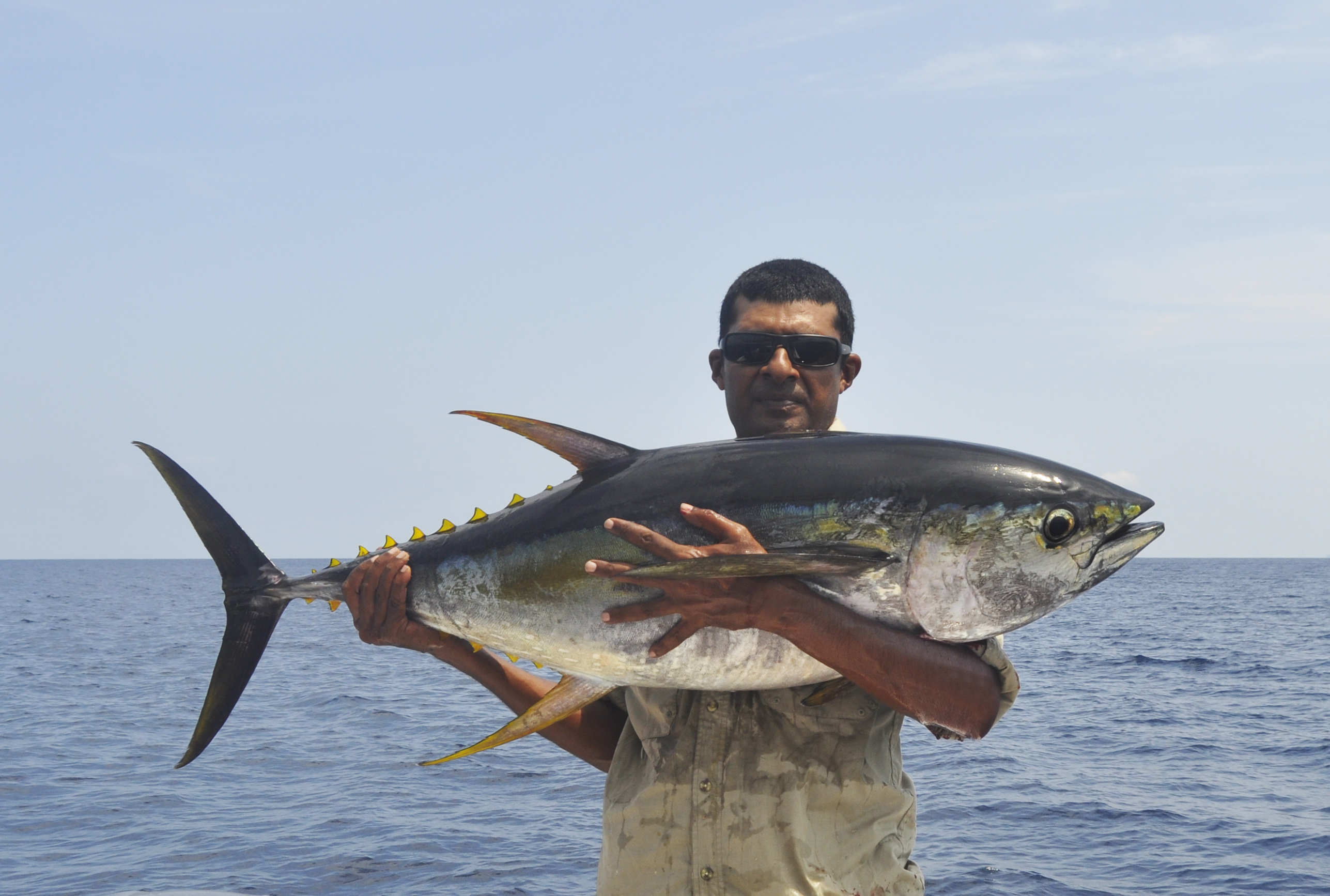

WAHOO
Scientific Name: Acanthocybium solandri
Local Name: Kawwa Surmai
Wahoo are often mistaken for Spanish Mackerel, despite looking quite different. They are prolific on the drop-offs and out in deep water close to sea mounts or some sort of underwater structure. They are notorious for biting off jigs with their razor sharp teeth. Wahoo also come up and take the occasional popper while fishing for tuna or in large offshore bait-schools. Wahoo can easily be caught trolling, but become a nuisance while marlin fishing, if one isn’t far enough from land. Again they are a highly sought after food fish for the tourism industry.
YELLOW SPOTTED TREVALLY
Scientific Name: Carangoides fulvoguttatus
Local Name: Cheet Kokari
Also known as the goldspotted trevally and tarrum is a widespread species of large inshore marine fish in the jack family Carangidae. The yellowspotted trevally inhabits the tropical and subtropical waters of the Indo-west Pacificregion, from South Africa in the west to Japan and Australia in the east. It is a predatory fish, attacking small fish, crabs and squid . It is considered an excellent sport fish by anglers and is a good table fish.



